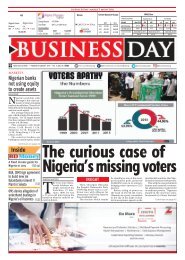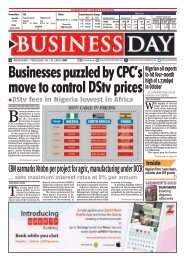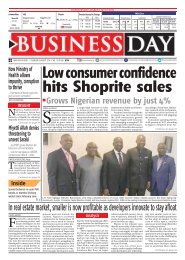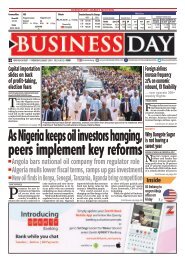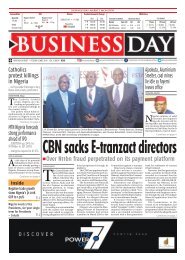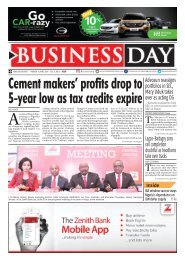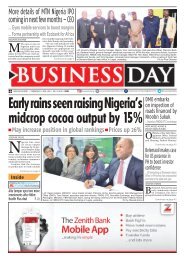BusinessDay 25 Oct 2017
Create successful ePaper yourself
Turn your PDF publications into a flip-book with our unique Google optimized e-Paper software.
Wednesday <strong>25</strong> <strong>Oct</strong>ober <strong>2017</strong><br />
10 BUSINESS DAY<br />
C002D5556<br />
COMMENT<br />
SMALL BUSINESS HANDBOOK<br />
EMEKA OSUJI<br />
Dr Emeka Osuji<br />
School of Management and<br />
Social Sciences<br />
Pan Atlantic University<br />
Lagos. eosuji@pau.edu.ng @Emyosuji<br />
Nigeria’s financial inclusion<br />
story is that<br />
in 2008 as much<br />
as 53.5 per cent of<br />
us were financially<br />
excluded. Government and the<br />
various stakeholders, especially<br />
the banks and regulators of the<br />
financial system worked very<br />
hard and by 2010 it had been<br />
brought down to about 42 per<br />
cent. The current target is to<br />
drive it down to a maximum of<br />
20 per cent by 2020. That figure<br />
cannot be said to be very low<br />
or overly ambitious, especially<br />
given the myriads of innovative<br />
payment systems coming up in<br />
the financial sector, although<br />
we are slow in adopting many<br />
of them.<br />
The question is why are we<br />
making very slow progress with<br />
financial inclusion? I believe the<br />
answer is not farfetched. To start<br />
with, the country has a large<br />
population of digitally illiterate<br />
people. Many university graduates<br />
are still not conversant<br />
with the use of computers. They<br />
have not received any computer<br />
BRIAN REUBEN<br />
Brian Reuben is a business advisor<br />
author and keynote speaker. www.brian.<br />
com.ng<br />
comment is free<br />
Send 800word comments to comment@businessdayonline.com<br />
The Many roadblocks to financial inclusion (3)<br />
training. And many of those<br />
who have such training cannot<br />
afford computers. Before long<br />
they lose their skills. Besides,<br />
many people still distrust the<br />
electronic banking systems<br />
because of their experiences<br />
with fraudsters and armed robbers.<br />
With armed robbers going<br />
about with POS machines and<br />
clearing victims’ accounts at<br />
gunpoint, many have distanced<br />
themselves from debit cards – a<br />
minus for financial inclusion.<br />
One would have thought that<br />
the machines and the merchants<br />
that have them are uniquely<br />
identified by the regulators to<br />
enable transactions to be traced.<br />
The financial infrastructure<br />
in the country is, like any other<br />
form of infrastructure in the<br />
country, very poor. Although<br />
progress has been made generally<br />
in the financial sector, to<br />
adapt technologies and innovations,<br />
the levers that will drive<br />
inclusion are not sufficiently<br />
emphasized. For instance, even<br />
with all the efforts made on the<br />
deployment of POS around the<br />
country, the adoption of that<br />
payment platform is still very<br />
low; again no thanks to the poor<br />
power supply and internet services.<br />
And the banks can help<br />
by not only ensuring that people<br />
have debit cards but can easily<br />
renew them, when expired. How<br />
many banks remind their customers<br />
when these debit cards<br />
are about to expire and make it<br />
easy for them to get new ones?<br />
These should be part of the frills<br />
that come with the accounts<br />
maintained by individuals;<br />
The real force behind growth and profitability<br />
nies loose half their customers<br />
every five years. The rate of customer<br />
defection is so high that<br />
some even argue that loyalty is<br />
dead. But that’s a serious mistake.<br />
How can someone say that?<br />
Loyalty is not dead. Every serious<br />
minded executive knows the importance<br />
of customer franchise.<br />
A company that doesn’t manage<br />
customer loyalty would soon go<br />
extinct especially as competition<br />
intensifies.<br />
The interesting thing is that<br />
any business can effectively command<br />
loyalty. All it requires is a<br />
simple understanding of the true<br />
purpose of business. For many,<br />
the purpose of business is to make<br />
profit. Everything rises and ends<br />
with how much profit a business<br />
is able to generate. Well, that’s<br />
true and if it is true, you want not<br />
just profit, but sustainable profit.<br />
And you can’t have sustainable<br />
profit by running after profit.<br />
Sustainable profit is the result<br />
of securing and sustaining the<br />
loyalty of your customers.<br />
The thing is, you don’t secure<br />
and sustain the loyalty of your<br />
customers through advertising,<br />
neither will sponsorship of any<br />
sort produce that. Many companies<br />
have focused on that and did<br />
it so well, yet have gone extinct.<br />
Customer loyalty is a natural<br />
consequence of creating value,<br />
value that blows the socks of your<br />
Data available on the use of<br />
POS shows that apart from<br />
Lagos, the FCT and Rivers,<br />
other states recorded less<br />
than N2million transactions<br />
in 2016. Worse still,<br />
over 50 per cent of the POS<br />
transactions took place in<br />
Lagos. And this number is<br />
even after the use of the POS<br />
had recorded a 123 per cent<br />
cumulative average growth<br />
rate between 2012 and<br />
2016<br />
after all they are not issued for<br />
free. It might help to justify some<br />
of those unwarranted picking<br />
of customers’ pockets we see all<br />
around. Some banks are however<br />
a head of others. I was pleasantly<br />
surprised when my bank was able<br />
to reissue mine within 48 hours.<br />
I am not sure this is universal<br />
among the banks. People can only<br />
patronize the POS if they have<br />
these cards that are current and<br />
functional.<br />
Again, the use of the POS is<br />
still limited to a few urban centres<br />
with advantages in the spatial<br />
distribution of bank branches and<br />
power supply. Data available on<br />
the use of POS shows that apart<br />
from Lagos, the FCT and Rivers,<br />
other states recorded less than<br />
N2million transactions in 2016.<br />
Worse still, over 50 per cent of<br />
customers away, well intended<br />
value designed to leave people’s life<br />
better. When a company focuses<br />
on creating value first, then their<br />
loyalty management efforts will<br />
produce lasting results.<br />
You can’t advertise deceit and<br />
expect to go very far in business.<br />
Sharp practices in pursuit of profit<br />
destroy customer loyalty. You cannot<br />
secure the loyalty of customers<br />
and sustain it through deceit. You<br />
may manipulate people’s mind<br />
into submission to your brand but<br />
watch it they will soon fetter away<br />
soon as they come to real terms<br />
with the value you offer them. I<br />
love the way Charlie Carwey, the<br />
founder of MBNA, an American<br />
credit card company thought about<br />
it. On the cover page of his company<br />
financial report he writes,<br />
“Success Is Getting the Right Customers<br />
. . . and Keeping Them.” That<br />
about says it all. In MBNA’s entire<br />
history, the company has suffered<br />
only a handful of defections from<br />
its thirty-seven hundred groups. By<br />
1994, its individual customer base<br />
had grown to more than 14 million<br />
cardholders!<br />
Based on all of these, the ultimate<br />
question is; how do I secure<br />
and sustain customer loyalty to my<br />
brand?<br />
First, understand that there is<br />
no short cut to anywhere meaningful.<br />
Building customer loyalty<br />
to your brand is not going to be an<br />
the POS transactions took place<br />
in Lagos. And this number is<br />
even after the use of the POS had<br />
recorded a 123 per cent cumulative<br />
average growth rate between<br />
2012 and 2016.<br />
Without doubt we need to<br />
work more seriously on a number<br />
of things including the power<br />
sector, the charges on bank<br />
services and the deployment<br />
of equipment. Perhaps a new<br />
form of rural baking programme<br />
focusing on the deployment of<br />
the POS and ATM machines and<br />
their use might be considered<br />
and if necessary compelled.<br />
In the good old days of the<br />
analog world we used to circulate<br />
our call cards with one<br />
feature prominently displayed<br />
– our post office boxes. This was<br />
to make sure that our mails were<br />
safely dropped into the right<br />
boxes. Post office boxes were the<br />
vogue and even seen as a sign of<br />
success, which conferred some<br />
prestige on those who had it,<br />
especially if they were individuals.<br />
We would walk majestically<br />
through the array of boxes to<br />
haul the many papers in our<br />
boxes to the admiration of some<br />
post office staff. Some even<br />
showed off with the volume of<br />
mails they extracted from their<br />
boxes. It indicated how active<br />
and important they and their<br />
businesses were. And because<br />
many companies did not have<br />
mail boxes, these (mail boxes)<br />
were at times seen as a mark<br />
of distinction and indicative of<br />
company status.<br />
In some cases, the mail bags<br />
(they began as bags and then<br />
overnight project. In fact, it is a life<br />
time project and always work in<br />
progress. You don’t start tomorrow<br />
morning and begin to expect<br />
instant results.<br />
Next, you will need to know<br />
that loyalty management should<br />
be a CEO’s function. Loyalty is<br />
too important to be considered<br />
the work of the marketing department.<br />
If CEOs will devote time<br />
looking at stock performance,<br />
they should do even much more<br />
for loyalty metrics. Of course the<br />
performance of the former depends<br />
on the latter. Reports have<br />
shown that even a slight improvement<br />
in customer retention by<br />
companies results in significant<br />
changes in financial performance.<br />
That’s how important it is.<br />
But most importantly is for the<br />
CEO to define the customer loyalty<br />
philosophy in the company. The<br />
customer loyalty philosophy of a<br />
company is the set of ideas, facts<br />
and convictions of the company<br />
as it relates to customer loyalty.<br />
It is this philosophy that defines<br />
the dimensions of their commitment<br />
to securing and sustaining<br />
the loyalty of their customers.<br />
Not only should this be defined,<br />
it should also be clearly communicated<br />
to everyone in the company,<br />
not once but on a regular<br />
basis. This will help everyone in<br />
the company develop a customer<br />
loyalty attitude, a predisposi-<br />
transmuted to boxes) were more<br />
famous than the companies that<br />
owned them. For instance, once<br />
you heard PMB 1022 everyone<br />
knew it was WAEC. But the world<br />
has changed. Nobody talks of<br />
mail bags now, even if they still<br />
use them. The world has gone<br />
over to emails. The same way<br />
we left our mail bag is the way<br />
we have to leave our old ways of<br />
moving money. It is now a digital<br />
world.<br />
Microfinance institutions<br />
have been in the forefront of<br />
the drive towards economic<br />
democratization and financial<br />
empowerment of the many less<br />
privileged but active citizens<br />
of our country. The sector has<br />
grown considerably over the<br />
past decade when commercial<br />
microfinancing was brought into<br />
focus. It has since transformed<br />
into an economic sector that<br />
serves both investors and the active<br />
poor. We currently have over<br />
a thousand microfinance banks<br />
working to get financial services<br />
across to less privileged citizens<br />
who are engaged in meaningful<br />
economic activity.The time<br />
for traditional banking services<br />
is over, even among the active<br />
poor. MFBs must embrace digital<br />
financing strategies, especially<br />
money transfer technologies.<br />
The regulations must by now<br />
be mauling the idea of recapitalization,<br />
especially among the<br />
N20million Unit MFBs. They<br />
cannot give what they do not<br />
have – money.<br />
Send reactions to:<br />
comment@businessdayonline.com<br />
How can an organization<br />
build a global force of<br />
loyal customers? How<br />
can you get people to<br />
submit to your brand? That’s a<br />
question every business leader<br />
sincerely care about the answer.<br />
This becomes even more pertinent<br />
in the face of rapidly increasing<br />
global connectedness. The<br />
limitations of distance have been<br />
done away with as international<br />
boundaries hold no real meaning<br />
to today’s consumers.<br />
In the past producers took their<br />
customers for granted, because at<br />
that time the customers were not<br />
demanding nor had alternative<br />
source of supply or suppliers. But<br />
today there is a radical shift. The<br />
changing business environment is<br />
characterized by economic liberalization,<br />
increasing competition,<br />
high consumer choice, demanding<br />
customer, more emphasis on<br />
quality and value of purchase.<br />
Reports indicate that compation<br />
to think, talk and act in ways<br />
that will communicate optimal<br />
value to the customers. Imagine a<br />
company where everyone thinks<br />
in terms of the customers. What<br />
kind of organisation do you think<br />
that will be?<br />
Finally, customer loyalty should<br />
be measured. It is sad that many<br />
organizations can’t really tell<br />
whether their customers are defecting<br />
or not. Customer loyalty<br />
works by the laws of economics<br />
and human behavior, which<br />
means there are practical, objective,<br />
mathematical, and answers<br />
to questions such as: Just exactly<br />
how much value does loyalty create<br />
(and vice-versa)? How do we<br />
quantify the link between loyalty<br />
and profits? What’s the actual cash<br />
advantage of holding onto a good<br />
customer for one additional year,<br />
or five years, or ten? There are<br />
accounting methods, cash flow,<br />
net present value, and probability<br />
used in measuring customer loyalty.<br />
Although I can’t get into that<br />
in details here, there is available<br />
literature to help you.<br />
No business without a customer<br />
loyalty culture can endure for<br />
so long. It is the core force behind<br />
growth and profitability.<br />
Send reactions to:<br />
comment@businessdayonline.com




